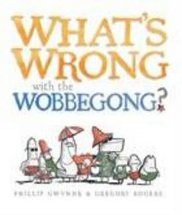What's wrong with the wobbegong? by Phillip Gwynne

What's wrong with the wobbegong? by Phillip Gwynne
Ill. by Gregory Rogers. Little Hare, 2013. ISBN 9781921714962.
(Age: 4+) Highly recommended. Seaside. Appearances. Gossip. As the
wobbegong lies on his towel on the beach, his manly chest puffed out
before him, he lathers sunscreen over his body, listens to his
radio, and very contentedly soaks up the sun. But his neighbours,
the humped whale, the seabird, the crab, octopus and clam are all
worried and cannot help but voice their concerns to each other.
There is something wrong with the wobbegong. He never seems to eat,
just lies palely on the sand without saying a word to anyone. But
just as they are all conjecture, he gets up and races to the sea,
proving that he can moved very quickly indeed. He is active and a
good colour, so the other beach creatures conclude that indeed there
is nothing wrong with the wobbegong until he suddenly gets a little
too close.
In boldly rhythmic lines, begging to be read aloud, the tale of the
sea animals unfolds. For the fist part of the tale, each page begins
with the question, 'What's wrong with the wobbegong?', while after
he rushes into the water, the concluding pages all begin with,
'There's nothing wrong with the wobbegong' making the tale neatly
symmetrical, adding spice to the children's perception of the clutch
of fish.
The astounding illustrations parallel the story with consummate
ease. The sea creatures are all distinct, each given a character
that is recognisable. The wobbegong is proud, and disinterested in
all that is going on around him; the seagull selling ice cream is
glowering and watchful; the humped whale a snoop and keen to
have some answers to her questions, gathering her brood around her;
while the little crab, ineffective but drawn to the wobbegong,
becomes his next meal.
The scene on the beach could be anywhere with any group: a mother
and her children, the lone swimmer, the small family groups, some in
the sea and some lying on their towels, many eating ice cream from
the lone ice cream seller; all watchful and questioning, keen to
have answers about the others on the beach. And all perfectly
replicated in the humorous illustrations.
For a funny tale of a scene on a beach, for a tale to introduce the
idea of not judging a book by its cover, or a moral tale of getting
just deserts, or of being careful of the unknown or of being wary of
strangers, the uses of this story are wide and various. But for me,
I laughed out loud on every page at both the text and drawings. Such
a treat.
Fran Knight